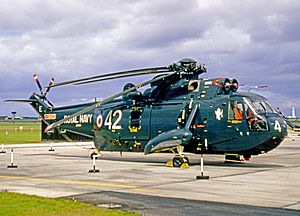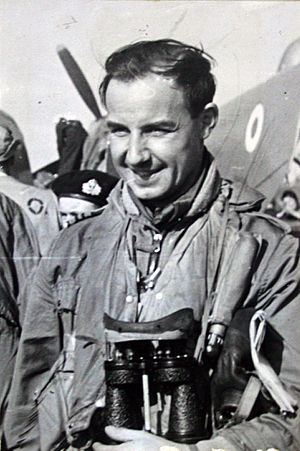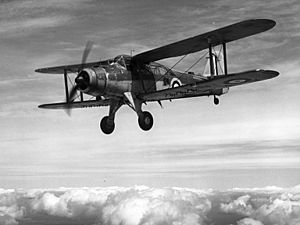826 Naval Air Squadron facts for kids
Quick facts for kids 826 Naval Air Squadron |
|
|---|---|

826 Squadron Westland Sea King HAS.1 based on HMS Eagle in 1970.
|
|
| Active | March 1940 – August 1943 December 1943 – October 1944 August 1945 – February 1946 ? – November 1955 March 1966 – March 1970 June 1970 – July 1993 |
| Country | UK |
| Branch | Royal Navy |
| Type | Carrier based squadron |
| Role | Torpedo Spotter Reconnaissance (TSR) |
| Part of | Fleet Air Arm |
| Battle honours | Dunkirk 1940, English Channel 1940–44, Atlantic 1940, Matapan 1941, Crete 1941, Mediterranean 1941–43, Libya 1941–2, Falklands 1982, Kuwait 1991 |
The 826 Naval Air Squadron was a special group of planes and pilots in the Royal Navy's Fleet Air Arm. It started during World War II and was brought back to life many times until 1993.
Contents
History
World War II
The 826 Squadron began in March 1940 at a place called RNAS Ford in Sussex, England. They flew 12 Fairey Albacore planes, which were biplanes (planes with two sets of wings) designed to drop torpedoes. Torpedoes are underwater missiles used to attack ships.
After training, they joined RAF Coastal Command. Their first mission was a bombing raid in Belgium on May 31, 1940. The squadron helped protect convoys (groups of ships) and attacked German targets. Sometimes, their Albacore planes had engine problems, so they temporarily used older Fairey Swordfish planes.
From August to October 1940, they attacked German barges that were gathering for a planned invasion of Britain called Operation Sealion. The squadron dropped many bombs and mines. They also claimed to have shot down two German fighter planes.
In November 1940, the squadron joined the new aircraft carrier HMS Formidable. They sailed to the Mediterranean Sea, attacking targets in Eritrea along the way. In March 1941, they got two more Swordfish planes.
The 826 Squadron took part in the Battle of Cape Matapan in March 1941. They helped damage a large Italian warship called Vittorio Veneto. In May 1941, after attacking an airfield, their carrier Formidable was badly damaged by German bombers. The squadron then had to operate from land.
The squadron flew night bombing missions in North Africa to support the Eighth Army. They also moved to Cyprus to fight against French naval forces. They returned to North Africa and continued bombing missions. In early 1942, they went back to dropping torpedoes, attacking Italian convoys from Libya.
They kept doing anti-ship and bombing missions, and also dropped flares to light up targets for other bombers. The squadron was involved in both the first and second Battles of El Alamein. After the British victory at El Alamein, they continued anti-ship and convoy escort missions until August 1943, when the squadron was temporarily stopped.
The 826 Naval Air Squadron started again on December 1, 1943. They were based at RNAS Lee-on-Solent and flew Fairey Barracuda torpedo bombers. In June 1944, they joined the carrier HMS Indefatigable. They took part in an attack against the German battleship Tirpitz in Norway. They also joined HMS Formidable for more attacks on Tirpitz in August 1944. The squadron was stopped again in October 1944.
After the Wars
Canada's Role
The squadron reformed on August 15, 1945, still with Barracuda planes. The plan was for them to join a carrier being built for the Royal Canadian Navy. In January 1946, they switched to Fairey Firefly fighter bombers. However, the squadron was stopped again in February 1946 because the carrier was delayed.
The squadron reformed on June 1, 1947, as part of the Royal Canadian Navy. They used Fairey Fireflys from Canadian carriers. In June 1950, they switched to Grumman TBM Avenger planes, which were used for finding submarines. On May 1, 1951, this squadron was renamed the 881 Naval Air Squadron.
New Beginnings
The 826 Squadron started again in May 1951 as part of the Fleet Air Arm. They used Firefly planes (soon replaced by Firefly AS. Mk.6) to hunt submarines. The squadron flew their Fireflys from carriers like HMS Indomitable and HMS Glory.
In January 1955, they got new Fairey Gannet anti-submarine planes, becoming the first squadron to use them. They joined HMS Eagle but were stopped again in November 1955.
Helicopters in Action
The 826 Squadron was brought back to life in 1966 at RNAS Culdrose. They were given 8 Westland Wessex HAS.1 helicopters. They joined HMS Hermes for a trip around the Mediterranean and Far East in 1966–1967. They also sent small groups of helicopters to support other ships. In 1969, they joined HMS Eagle. The squadron was stopped at RNAS Culdrose on March 25, 1970.
It reformed for the sixth time on June 2, 1970, with Westland Sea King helicopters. They served on HMS Eagle until the carrier was taken out of service in January 1972. The squadron then operated from the training ship RFA Engadine and, from December 1972, from the cruiser HMS Tiger. They continued to use their Sea Kings from Tiger until 1978. Then they moved to the carrier Bulwark, getting newer Sea King HAS.5s in March 1981.
After the Argentinian invasion of the Falkland Islands in April 1982, the squadron joined the Task Force sent to take back the islands. They had nine Sea King HAS.5s and deployed aboard HMS Hermes. The squadron flew patrols to find submarines and search the sea around the task force. They also rescued people from damaged ships like HMS Sheffield and Atlantic Conveyor.
The squadron lost two helicopters during the Falklands War, but thankfully, all the crews survived. After the war, the squadron was split into smaller groups that operated from different Royal Fleet Auxiliary ships. These operations continued until 1986. After that, the squadron was split into four groups of two Sea Kings each, working from frigates, RFAs, and aircraft carriers.
In December 1990, before the First Gulf War began, a part of 826 Squadron went to the Middle East. Their Sea King helicopters were changed to try and find mines in shallow water. This equipment was not very effective, so the crews had to spot mines visually from the air. These mines were then destroyed by divers. During this time, the squadron operated from different ships. In April 1991, the crews returned home. One Sea King helicopter was lost in a collision with a ship, but the crew and passengers survived.
The squadron's aircraft were later given to other squadrons. The 826 Naval Air Squadron was then stopped for the last time in July 1993.
Aircraft operated
| From | To | Aircraft | Version | Notes |
|---|---|---|---|---|
| March 1940 | August 1943 | Fairey Albacore | I | |
| July 1940
March 1941 |
August 1940
September 1941 |
Fairey Swordfish | I | |
| December 1943 | October 1944 | Fairey Barracuda | II | |
| August 1945 | January 1946 | Fairey Barracuda | II(ASH) | Fitted with Air-to-Surface H radar for finding things on the surface. |
| January 1946
May 1947 |
February 1946
October 1950 |
Fairey Firefly | FR.1 | |
| December 1948 | January 1949 | Fairey Firefly | T.1 | |
| October 1950 | May 1951 | Grumman Avenger | TBM-3E | |
| May 1951 | January 1955 | Fairey Firefly | AS.6 | |
| January 1955 | November 1955 | Fairey Gannet | AS.1 | |
| March 1966 | October 1968 | Westland Wessex | HAS.1 | |
| October 1968 | March 1970 | Westland Wessex | HAS.3 | |
| June 1970 | December 1976 | Westland Sea King | HAS.1 | |
| December 1976 | March 1981 | Westland Sea King | HAS.2/2a | |
| March 1981 | May 1993 | Westland Sea King | HAS.5 | |
| April 1988 | July 1993 | Westland Sea King | HAS.6 |




